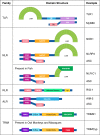Intracellular immunity: finding the enemy within--how cells recognize and respond to intracellular pathogens
- PMID: 24899588
- PMCID: PMC4192899
- DOI: 10.1189/jlb.4RI0214-090R
Intracellular immunity: finding the enemy within--how cells recognize and respond to intracellular pathogens
Abstract
Historically, once a cell became infected, it was considered to be beyond all help. By this stage, the invading pathogen had breached the innate defenses and was beyond the reach of the humoral arm of the adaptive immune response. The pathogen could still be removed by cell-mediated immunity (e.g., by NK cells or cytotoxic T lymphocytes), but these mechanisms necessitated the destruction of the infected cell. However, in recent years, it has become increasingly clear that many cells possess sensor and effector mechanisms for dealing with intracellular pathogens. Most of these mechanisms are not restricted to professional immune cells nor do they all necessitate the destruction of the host. In this review, we examine the strategies that cells use to detect and destroy pathogens once the cell membrane has been penetrated.
Keywords: DAMP; PAMP; pathogen sensing.
© 2014 Society for Leukocyte Biology.
Figures


Similar articles
-
NK cells inhibit humoral immunity by reducing the abundance of CD4+ T follicular helper cells during a chronic virus infection.J Leukoc Biol. 2015 Aug;98(2):153-62. doi: 10.1189/jlb.4HI1214-594R. Epub 2015 May 18. J Leukoc Biol. 2015. PMID: 25986014 Free PMC article.
-
NK cells regulate CD8+ T cell effector function in response to an intracellular pathogen.J Immunol. 2004 Jan 1;172(1):130-7. doi: 10.4049/jimmunol.172.1.130. J Immunol. 2004. PMID: 14688318
-
Natural killer cells promote early CD8 T cell responses against cytomegalovirus.PLoS Pathog. 2007 Aug 24;3(8):e123. doi: 10.1371/journal.ppat.0030123. PLoS Pathog. 2007. PMID: 17722980 Free PMC article.
-
Molecular characterization of HCMV-specific immune responses: Parallels between CD8(+) T cells, CD4(+) T cells, and NK cells.Eur J Immunol. 2015 Sep;45(9):2433-45. doi: 10.1002/eji.201545495. Epub 2015 Aug 24. Eur J Immunol. 2015. PMID: 26228786 Review.
-
Interleukin-17 acts as double-edged sword in anti-tumor immunity and tumorigenesis.Cytokine. 2017 Jan;89:34-44. doi: 10.1016/j.cyto.2015.09.011. Epub 2016 Feb 14. Cytokine. 2017. PMID: 26883678 Review.
Cited by
-
Poxviruses package viral redox proteins in lateral bodies and modulate the host oxidative response.PLoS Pathog. 2022 Jul 14;18(7):e1010614. doi: 10.1371/journal.ppat.1010614. eCollection 2022 Jul. PLoS Pathog. 2022. PMID: 35834477 Free PMC article.
-
Emergence of the fungal immune system.iScience. 2023 May 2;26(6):106793. doi: 10.1016/j.isci.2023.106793. eCollection 2023 Jun 16. iScience. 2023. PMID: 37213230 Free PMC article. Review.
-
Immunogenicity of In Vitro-Transcribed RNA.Acc Chem Res. 2021 Nov 2;54(21):4012-4023. doi: 10.1021/acs.accounts.1c00521. Epub 2021 Oct 22. Acc Chem Res. 2021. PMID: 34677064 Free PMC article. Review.
-
Unresolved issues in theories of autoimmune disease using myocarditis as a framework.J Theor Biol. 2015 Jun 21;375:101-123. doi: 10.1016/j.jtbi.2014.11.022. Epub 2014 Dec 4. J Theor Biol. 2015. PMID: 25484004 Free PMC article. Review.
-
The Type II Secretion System of Legionella pneumophila Dampens the MyD88 and Toll-Like Receptor 2 Signaling Pathway in Infected Human Macrophages.Infect Immun. 2017 Mar 23;85(4):e00897-16. doi: 10.1128/IAI.00897-16. Print 2017 Apr. Infect Immun. 2017. PMID: 28138020 Free PMC article.
References
-
- Rajewsky K. (1996) Clonal selection and learning in the antibody system. Nature 381, 751–758 - PubMed
-
- Fontana M. F., Vance R. E. (2011) Two signal models in innate immunity. Immunol. Rev. 243, 26–39 - PubMed
-
- Janeway C. A., Jr., (2013) Pillars article: approaching the asymptote? Evolution and revolution in immunology. Cold Spring Harb. Symp. Quant. Biol. 1989. 54: 1–13. J. Immunol. 191, 4475–487 - PubMed
-
- Medzhitov R. (2009) Approaching the asymptote: 20 years later. Immunity 30, 766–775 - PubMed
-
- Medzhitov R. (2013) Pattern recognition theory and the launch of modern innate immunity. J. Immunol. 191, 4473–4474 - PubMed
Publication types
MeSH terms
Grants and funding
LinkOut - more resources
Full Text Sources
Other Literature Sources

